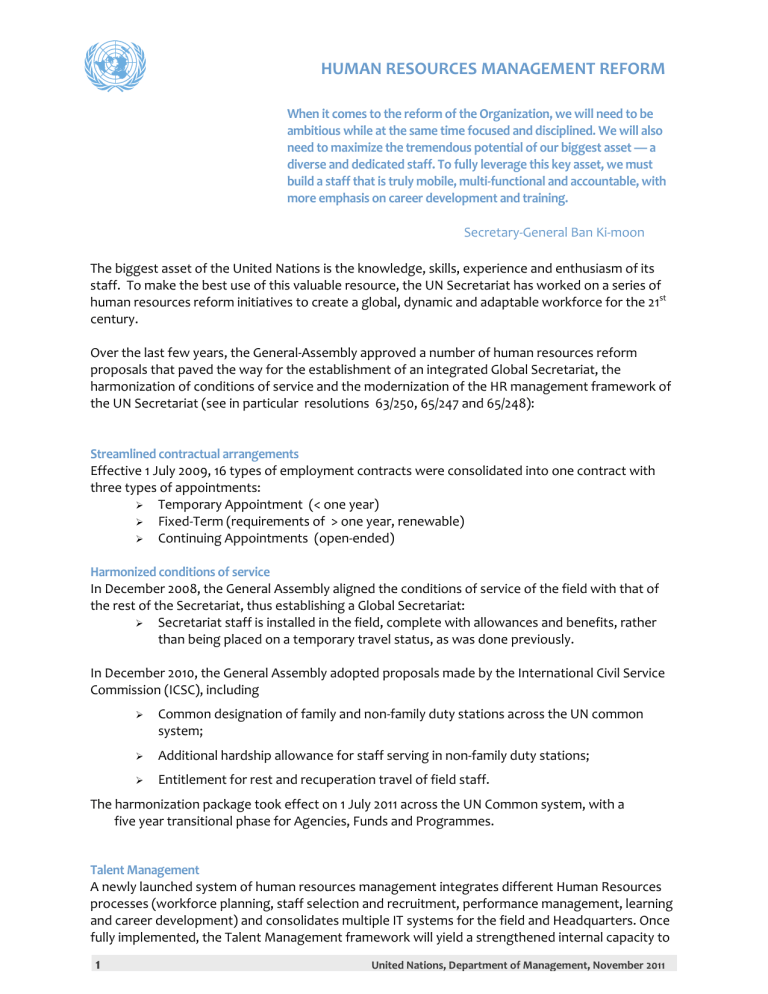Human Resources Management Reform

HUMAN RESOURCES MANAGEMENT REFORM
When it comes to the reform of the Organization, we will need to be ambitious while at the same time focused and disciplined. We will also need to maximize the tremendous potential of our biggest asset — a diverse and dedicated staff. To fully leverage this key asset, we must build a staff that is truly mobile, multi-functional and accountable, with more emphasis on career development and training.
Secretary-General Ban Ki-moon
The biggest asset of the United Nations is the knowledge, skills, experience and enthusiasm of its staff. To make the best use of this valuable resource, the UN Secretariat has worked on a series of human resources reform initiatives to create a global, dynamic and adaptable workforce for the 21 century. st
Over the last few years, the General-Assembly approved a number of human resources reform proposals that paved the way for the establishment of an integrated Global Secretariat, the harmonization of conditions of service and the modernization of the HR management framework of the UN Secretariat (see in particular resolutions 63/250, 65/247 and 65/248):
Streamlined contractual arrangements
Effective 1 July 2009, 16 types of employment contracts were consolidated into one contract with three types of appointments:
Ø
Temporary Appointment (< one year)
Ø
Ø
Fixed-Term (requirements of > one year, renewable)
Continuing Appointments (open-ended)
Harmonized conditions of service
In December 2008, the General Assembly aligned the conditions of service of the field with that of the rest of the Secretariat, thus establishing a Global Secretariat:
Ø
Secretariat staff is installed in the field, complete with allowances and benefits, rather than being placed on a temporary travel status, as was done previously.
In December 2010, the General Assembly adopted proposals made by the International Civil Service
Commission (ICSC), including
Ø
Ø
Ø
Common designation of family and non-family duty stations across the UN common system;
Additional hardship allowance for staff serving in non-family duty stations;
Entitlement for rest and recuperation travel of field staff.
The harmonization package took effect on 1 July 2011 across the UN Common system, with a
five year transitional phase for Agencies, Funds and Programmes.
Talent Management
A newly launched system of human resources management integrates different Human Resources processes (workforce planning, staff selection and recruitment, performance management, learning and career development) and consolidates multiple IT systems for the field and Headquarters. Once fully implemented, the Talent Management framework will yield a strengthened internal capacity to
1
United Nations, Department of Management, November 2011
Human Resources Management Reform plan, execute, monitor and report on Human Resources issues across the Global Secretariat and better equip the Organization to meet current and future staffing needs.
Ø
Recruitment: To ensure more consistency in hiring practices, use a standardized methodology for evaluating candidates across the global Secretariat, and make the process more efficient, an overhauled staff selection system was introduced in April 2010.
Ø
Performance Management: To improve overall organizational performance and strengthen personal accountability, a new Performance Management and Development
System was introduced in April 2010. In line with agreed performance standards, the new system encourages staff participation in the planning and delivery of work. Training for managers and supervisors was made mandatory via a Secretary-General's Bulletin in mid-
2011. Initially planned for April 2011, the Inspira e-Performance module will be rolled out globally in April 2012. This is due to essential stabilization work being conducted on the
Inspira recruitment module.
Ø
Learning Management: To support the global workforce in delivering high performance and to maintain and develop their professional and managerial competence, a learning strategy was adopted in 2009 that expands learning opportunities and streamlines learning management around the globe. It establishes a minimum target of training days per year for each staff, identifies strategic priorities and learning plans, and provides training opportunities through a newly-launched e-learning platform accessible to staff globally.
Ø
Young Professionals Programme: To attract new talent and improve geographical representation of under/unrepresented Member States, in December 2010, the General
Assembly approved measures to streamline the selection and placement process for entry level staff. The Young Professional Programme replaces the National Competitive
Recruitment Examination and will provide additional opportunities for junior staff members to gain experience in different duty stations and serve in field missions as well as in Headquarters locations.
Staff mobility
The Secretary-General is committed to the concept of staff mobility to meet the needs of the
Organization in duty stations around the world and to offer staff members the opportunity to acquire new skills, broaden their knowledge, and gain experiences in different areas of responsibility.
Over the last few years, various initiatives have been launched to support staff mobility, such as the
Managed Reassignment Programme for junior professionals. The General Assembly has asked for a comprehensive mobility policy for the Secretariat to be presented to it at its 67 th session, and a working group of the Staff Management Committee is leading on taking work on this forward, in consultation with all stakeholders.
2
United Nations, Department of Management, November 2011